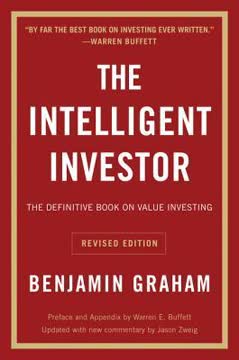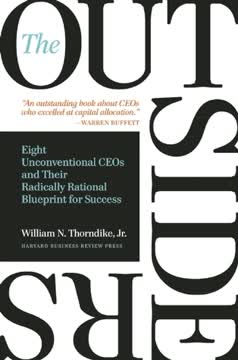Key Takeaways
1. Develop a robust investment philosophy centered on economic moats
Economic moats allow a relatively small number of companies to retain above-average levels of profitability for many years, and these companies are often the most superior long-term investments.
Economic moats are crucial for sustained competitive advantage and long-term profitability. They come in various forms:
- High customer switching costs
- Network effects
- Cost advantages
- Intangible assets (brands, patents)
- Efficient scale
Identifying moats requires analysis of:
- Historical profitability (ROE, ROA, free cash flow)
- Sources of competitive advantage
- Estimated duration of the advantage
- Industry competitive structure
Companies with wide economic moats, such as Microsoft, Coca-Cola, and Wal-Mart, tend to outperform over time by maintaining their competitive edge and generating consistent returns above their cost of capital.
2. Master financial statement analysis to uncover company health
Cash flow is the true measure of a company's financial performance, not reported earnings per share.
Understanding financial statements is crucial for evaluating a company's true financial health and performance. Key areas to focus on include:
- Balance Sheet: Assets, liabilities, and equity
- Income Statement: Revenue, expenses, and profitability
- Cash Flow Statement: Operating, investing, and financing activities
Important financial metrics to analyze:
- Free cash flow
- Return on equity (ROE) and return on assets (ROA)
- Debt-to-equity ratio
- Operating margin
- Inventory turnover
Investors should pay special attention to cash flow, as it provides a clearer picture of a company's financial health than reported earnings. Cash flow analysis helps identify potential issues such as aggressive revenue recognition or inventory management problems that may not be apparent from earnings figures alone.
3. Identify and avoid common investing pitfalls and accounting tricks
Avoiding mistakes is the most profitable strategy of all.
Common investing mistakes to avoid include:
- Swinging for the fences with high-risk stocks
- Believing "it's different this time"
- Falling in love with products instead of financials
- Panicking during market downturns
- Trying to time the market
- Ignoring valuation
Watch for accounting red flags such as:
- Declining cash flow despite rising earnings
- Frequent one-time charges or write-downs
- Aggressive revenue recognition
- Unexplained changes in key financial ratios
- Off-balance sheet liabilities
Investors should approach financial statements with healthy skepticism and look for discrepancies between reported earnings and cash flow. Understanding common accounting tricks, such as channel stuffing or cookie jar reserves, can help identify potential problems before they impact investment returns.
4. Value stocks using intrinsic value and margin of safety principles
The value of a stock is equal to the present value of its future cash flows. No more and no less.
Intrinsic value calculation involves:
- Estimating future cash flows
- Determining an appropriate discount rate
- Calculating the present value of those cash flows
Margin of safety is crucial for protecting against valuation errors and unforeseen circumstances. Key principles:
- Buy stocks at a significant discount to intrinsic value
- Larger margins of safety for riskier or less predictable businesses
- Patience in waiting for attractive valuations
Valuation tools such as discounted cash flow analysis, price-to-earnings ratios, and price-to-book ratios can help estimate a stock's intrinsic value. However, investors should use multiple methods and always incorporate a margin of safety to account for potential errors in assumptions or unexpected events.
5. Understand sector-specific dynamics to make informed investment decisions
It's easier for companies to make money in some industries than in others.
Different sectors have unique characteristics that impact investment potential:
- Technology: High growth potential but rapid change and obsolescence risk
- Healthcare: Demographic tailwinds but regulatory and litigation risks
- Consumer Goods: Stable demand but intense competition and low growth
- Financials: Leverage can amplify returns but also increases risk
- Industrials: Cyclical nature tied to economic conditions
Key factors to consider when analyzing sectors:
- Competitive landscape and barriers to entry
- Regulatory environment
- Growth prospects and market saturation
- Technological disruption potential
- Economic sensitivity
Understanding sector-specific dynamics helps investors identify promising opportunities and potential risks. For example, technology companies may offer high growth potential but face rapid obsolescence, while consumer staples provide stability but limited growth opportunities.
6. Focus on companies with sustainable competitive advantages
Companies with wide economic moats can retain above-average levels of profitability for many years, and these companies are often the most superior long-term investments.
Characteristics of companies with sustainable advantages:
- Consistent high returns on capital
- Pricing power
- Strong brand recognition
- Dominant market share
- Unique assets or technology
Examples of wide-moat companies:
- Coca-Cola: Brand power and distribution network
- Microsoft: Network effects and high switching costs
- Visa: Two-sided network effect in payments
- Amazon: Scale advantages and network effects
Companies with sustainable competitive advantages are better positioned to withstand economic downturns, fend off competition, and generate consistent returns for shareholders. These firms often have the ability to reinvest capital at high rates of return, compounding shareholder value over time.
7. Practice disciplined, long-term investing for optimal returns
Successful investing is simple, but it's not easy.
Key principles of disciplined investing:
- Develop a sound investment philosophy
- Focus on company fundamentals, not short-term price movements
- Maintain a long-term perspective
- Diversify intelligently
- Stay rational and avoid emotional decisions
Benefits of long-term investing:
- Lower transaction costs and taxes
- Ability to benefit from compounding returns
- Reduced impact of short-term market volatility
- Time for investment theses to play out
Disciplined, long-term investing requires patience and the ability to withstand short-term market fluctuations. By focusing on high-quality companies with sustainable competitive advantages and holding them for extended periods, investors can maximize their chances of achieving superior returns over time.
Last updated:
FAQ
What's The Five Rules for Successful Stock Investing about?
- Investment Principles Overview: The book outlines five core principles for successful stock investing, focusing on thorough research, economic moats, margin of safety, long-term holding, and knowing when to sell.
- Focus on Fundamentals: It emphasizes understanding a company's fundamental financial performance, linking business success directly to stock prices.
- Long-Term Approach: The author advocates for ignoring short-term market fluctuations and concentrating on the intrinsic value of companies.
Why should I read The Five Rules for Successful Stock Investing?
- Practical Guidance: The book offers practical advice and a structured approach, suitable for both novice and experienced investors.
- Avoid Common Mistakes: It helps readers avoid common investing errors, such as emotional reactions and market timing.
- Framework for Analysis: Provides a framework for evaluating companies, enhancing investment decision-making through financial statement analysis and management assessment.
What are the key takeaways of The Five Rules for Successful Stock Investing?
- Five Core Principles: Emphasizes doing your homework, finding economic moats, maintaining a margin of safety, holding investments long-term, and knowing when to sell.
- Importance of Economic Moats: Highlights the role of economic moats in maintaining profitability and fending off competition.
- Valuation Matters: Stresses the importance of valuation, advocating for a margin of safety in investments.
What are the five rules for successful stock investing mentioned in The Five Rules for Successful Stock Investing?
- Understand the Business: Know how a company makes money and its competitive landscape.
- Assess the Competitive Advantage: Identify sustainable economic moats that protect the company from competitors.
- Analyze Financial Health: Review financial metrics like cash flow, debt levels, and profit margins.
- Evaluate Management Quality: Assess the management team's track record and integrity.
- Be Patient and Disciplined: Maintain a long-term perspective and avoid impulsive decisions.
What is an economic moat, as defined in The Five Rules for Successful Stock Investing?
- Competitive Advantage: An economic moat is a company's competitive advantage that protects it from competitors.
- Sources of Moats: Includes brand loyalty, cost advantages, network effects, and high switching costs.
- Sustainability: Companies with strong moats can maintain above-average profitability, making them attractive long-term investments.
How does The Five Rules for Successful Stock Investing suggest evaluating a company's financial health?
- Key Metrics: Analyze return on equity (ROE), return on assets (ROA), and free cash flow.
- Debt Management: Understand a company's debt levels and financial leverage.
- Liquidity Ratios: Examine liquidity ratios like the current ratio and quick ratio to assess short-term obligations.
How does Pat Dorsey define "economic moat" in The Five Rules for Successful Stock Investing?
- Competitive Advantage Concept: An economic moat is a company's ability to maintain competitive advantages over rivals.
- Types of Moats: Includes brand loyalty, cost advantages, network effects, and regulatory advantages.
- Importance for Investors: Helps identify companies likely to outperform peers over time.
What valuation methods are discussed in The Five Rules for Successful Stock Investing?
- Discounted Cash Flow (DCF): Estimates a stock's intrinsic value based on future cash flows.
- Price-to-Earnings (P/E) Ratio: Compares with historical averages and industry peers to assess valuation.
- Price-to-Book (P/B) Ratio: Useful for valuing companies with significant tangible assets.
What are the common mistakes to avoid in stock investing, according to The Five Rules for Successful Stock Investing?
- Emotional Investing: Avoid panicking during market downturns or falling in love with products.
- Market Timing: Cautions against trying to time the market, as it's nearly impossible to predict short-term movements.
- Ignoring Valuation: Stresses the importance of not buying stocks without a margin of safety.
How does The Five Rules for Successful Stock Investing define margin of safety?
- Investment Cushion: The margin of safety is the difference between a stock's intrinsic value and its market price.
- Risk Mitigation: Helps mitigate the risk of overpaying for a stock.
- Percentage Guidelines: Suggests varying margins of safety based on the company's risk profile.
What financial metrics should I focus on when evaluating a stock according to The Five Rules for Successful Stock Investing?
- Cash Flow Analysis: Focus on cash flow from operations as a key indicator of financial health.
- Debt Levels: Assess the debt-to-equity ratio to understand financial leverage.
- Profit Margins: Evaluate profit margins to gauge efficiency and pricing power.
What are the best quotes from The Five Rules for Successful Stock Investing and what do they mean?
- "The best companies are those that can maintain a competitive advantage.": Highlights the importance of economic moats for consistent returns.
- "Investing is not about predicting the future; it’s about understanding the present.": Emphasizes thorough analysis over market predictions.
- "A company’s financial health is the foundation of its long-term success.": Stresses the necessity of evaluating financial metrics for viability.
Review Summary
The Five Rules for Successful Stock Investing is highly praised for its comprehensive approach to value investing. Readers appreciate Dorsey's clear explanations of financial concepts, valuation methods, and industry analysis. The book is considered excellent for beginners, providing a solid foundation in fundamental analysis and identifying quality businesses. While some find certain sections outdated or basic, many reviewers highlight its practical advice on avoiding common pitfalls and building a strong investment strategy. Overall, it's regarded as an essential read for those seeking long-term success in the stock market.
Similar Books










Download PDF
Download EPUB
.epub digital book format is ideal for reading ebooks on phones, tablets, and e-readers.





